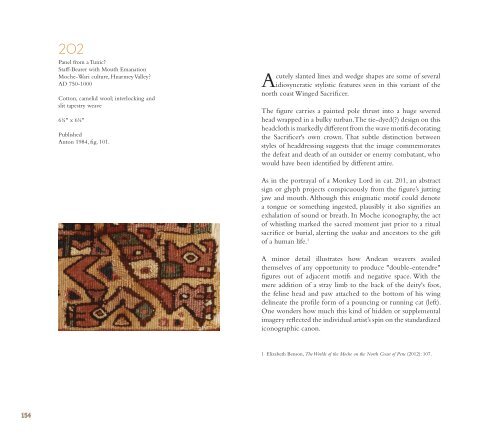Create successful ePaper yourself
Turn your PDF publications into a flip-book with our unique Google optimized e-Paper software.
202<br />
Panel from a Tunic?<br />
Staff-Bearer with Mouth Emanation<br />
Moche-Wari culture, Huarmey Valley?<br />
AD 750-1000<br />
Cotton, camelid wool; interlocking and<br />
slit tapestry weave<br />
6¼" x 6¼"<br />
Published<br />
Anton 1984, fig. 101.<br />
Acutely slanted lines and wedge shapes are some of several<br />
idiosyncratic stylistic features seen in this variant of <strong>the</strong><br />
north coast Winged Sacrificer.<br />
The figure carries a painted pole thrust into a huge severed<br />
head wrapped in a bulky turban. The tie-dyed(?) design on this<br />
headcloth is markedly different from <strong>the</strong> wave motifs decorating<br />
<strong>the</strong> Sacrificer's own crown. That subtle distinction between<br />
styles of headdressing suggests that <strong>the</strong> image commemorates<br />
<strong>the</strong> defeat and death of an outsider or enemy combatant, who<br />
would have been identified by different attire.<br />
As in <strong>the</strong> portrayal of a Monkey Lord in cat. 201, an abstract<br />
sign or glyph projects conspicuously from <strong>the</strong> figure’s jutting<br />
jaw and mouth. Although this enigmatic motif could denote<br />
a tongue or something ingested, plausibly it also signifies an<br />
exhalation of sound or breath. In Moche iconography, <strong>the</strong> act<br />
of whistling marked <strong>the</strong> sacred moment just prior to a ritual<br />
sacrifice or burial, alerting <strong>the</strong> wakas and ancestors to <strong>the</strong> gift<br />
of a human life. 1<br />
A minor detail illustrates how Andean weavers availed<br />
<strong>the</strong>mselves of any opportunity to produce "double-entendre"<br />
figures out of adjacent motifs and negative space. With <strong>the</strong><br />
mere addition of a stray limb to <strong>the</strong> back of <strong>the</strong> deity's foot,<br />
<strong>the</strong> feline head and paw attached to <strong>the</strong> bottom of his wing<br />
delineate <strong>the</strong> profile form of a pouncing or running cat (left).<br />
One wonders how much this kind of hidden or supplemental<br />
imagery reflected <strong>the</strong> individual artist’s spin on <strong>the</strong> standardized<br />
iconographic canon.<br />
1 Elizabeth Benson, The Worlds of <strong>the</strong> Moche on <strong>the</strong> North Coast of Peru (2012): 107.<br />
154







